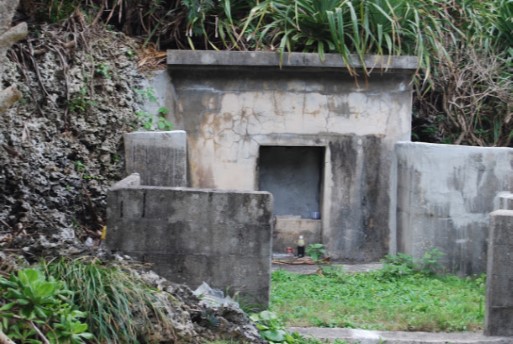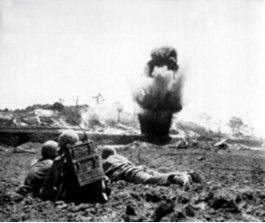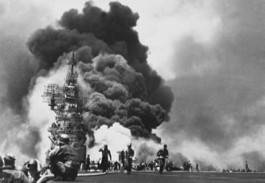April Fools Joke
In March 1945 we sailed aboard the USS Leon (APA 48) for Okinawa, stopping at the fleet anchorage at Ulithi Atoll in the Gilbert Islands for a hot beer bust, while a fleet of over 1500 ships assembled for the invasion. The U.S. Navy had assembled 40 aircraft carriers and 18 battleships in addition to destroyers, cruisers, supply ships, and troop ships in what was to be the largest invasion fleet during WWII.
Easter Sunday, 1 April 1945. Instead of “D-Day”, it was called “Love Day.” We expected to meet heavy opposition in the landing, but it was “April Fool’s Day” and much to our surprise, the joke was on us. In what is known as the “Damnedest Battlefield,” there was no sign of the enemy!
Okinawa is 60 miles long and from two to 18 miles wide. The 6th Marine Division was given the task of capturing the northern half of the island. It was a week before we encountered any enemy, and then we were ambushed time and again. The north was mountainous terrain defended by Navy personnel using anti-aircraft weapons as anti-personnel. The anti-aircraft fire bursts were very effective and demoralizing.
 Marines wade ashore on Okinawa
Marines wade ashore on Okinawa
A battalion on a mountain behind us had placed their pastel-colored front line markers out, and anything in front of those panels would normally be the enemy. Thus two of our Marine Corsairs fired four rockets at us causing several casualties. We set off color smoke canisters to indicate we were “friendly.” The pilots must have felt bad, but hopefully they realized it was not their fault.
The USS West Virginia was in direct support of us firing its 16-inch guns with projectiles that weighed three thousand pounds and were so large you could hear and see them as they passed overhead. Other large battleships, such as the USS Missouri, were also in support. We discovered a number of “suicide boats” loaded with explosives intended to explode when they rammed a ship, thus sinking the ship.
I was accepting the surrender of about twenty civilians when one pulled a grenade. He was determined to use it, but I was more determined that he would not, and I wrestled it away from him. It’s possible he intended to use it on himself. On Saipan many civilians jumped to their deaths off cliffs into the ocean because the Japanese had told them we would torture, rape, and kill them. We were trying to prevent that on Okinawa.
It was 14 April when we learned that President Roosevelt had died. We were also told that Russia had declared war on Japan, which raised our morale. It was probably intended to do just that, as Russia did not actually declare war on Japan until August.
A Chaplain could be Catholic, Jewish, or Protestant. When a Marine was killed, any one of them could offer last rights or words. They also held church services and communion when possible using an improvised altar or a folding table covered by a cloth. I can remember attending one worship service when mortars began landing close by, but that did not sway the Chaplain and he continued to serve every man communion before ending the service.
One evening, a Jap Zero, whose engine was made by Mitsubishi, flew not more than fifty feet overhead (i.e., real close) with a gull wing Marine Corsair on his tail. The Corsair pilot fired a short burst from his machine guns, and we watched the Jap pilot climb onto the wing of the Zero just before it crashed. It must not have been a kamikaze, as it did not explode. The pilot was still alive, but a Marine assisted him in dying honorably for his Emperor.
Moving South
It took us about two weeks of gorilla fighting to capture the northern half of the island. We were then sent south where the main line of defense had been established across the island.
 traditional tomb on Okinawa
traditional tomb on Okinawa
The southern half of Okinawa was rolling hills with agriculture. Here, 90% of the population lived, including a large population in Naha, the capital city. Scattered among the country side were tombs built into the hillsides. They were ornate in design with a small walled courtyard in front. They were made of concrete, and the inside was about the size of a small bedroom with stair step-like concrete ledges on which stood ceramic colored urns containing the ashes of loved ones.
On one occasion the Japs had tunneled between three tombs and were causing heavy casualties with machine guns. I tossed a twenty-pound explosive charge into one, only to have a machine gun return fire. This is when we realized that the tombs were interconnected. We arranged simultaneous attacks on all of the tombs using numerous hand grenades and smoke grenades to locate any undiscovered openings. I condemned the Japanese for the sacrilegious act of using burial tombs.
Assault on Sugar Loaf Hill
The 6th Division zone of action became a triangle of hills about 150 feet high known as Sugar Loaf, Half Moon, and Crescent. They were the anchor to the main Japanese defense line that ran across the narrow part of the island. If they fell, so would the entire Japanese defense system. The Japanese had perfected a near impregnable defense system with interconnected underground tunnels and rooms, complete with electricity. Each hill was capable of protecting the others.
When we attacked, we received fire from not only our front but also from our flanks and our rear. The 22nd Marine Regiment was the first to attack, but they suffered so many casualties that the 29th Regiment relieved them. It was raining, and in one attack I was crawling in the depression of a tank track that was about a foot deep and eighteen inches wide. The tank was drawing a lot of artillery fire, and it was told to back down. Suddenly I found myself about to be crushed by one of our own tanks! I managed to find other protection very quickly.
The Japanese were desperate enough to make banzai attacks (human wave attacks mounted by infantry units), which were costly to both them and us. I was just below the crest of the hill when I looked back to see a large number of bodies of both Marines and Japs littering the battlefield. More were added each day. Some bloated bodies had been there so long they turned black. The stench was nauseating. There were several disabled tanks and amphibious tractors among them. One Marine sat on what he thought was a log. Instead, he discovered it was the charred body of a Jap soldier. Some replacements were killed before I even learned their names. One twin was killed; the other grieved himself to death.
Casualty Tag: “Concussion”
We were trading hand grenades with the Japs near the crest of the hill, trying to hold our position to avoid having to make another costly assault, when there was a large explosion. The next thing I remember is regaining consciousness in a field hospital. My casualty tag read “Concussion.” I believe that my foxhole buddy took the brunt of the force (probably from an artillery shell), as he was badly wounded and evacuated to a hospital ship. After I had been hospitalized for 36 hours, I requested a release because I felt guilty watching how overwhelmed the doctors were with badly wounded Marines. Permission was granted, and I returned to the battle just in time to make the final assault on Sugar Loaf in a flanking movement to envelope it. Army tanks from several hundred yards away opened fire on us, killing Lengyl.
We took Sugar Loaf eleven times in ten days. Each assault resulted in several hundred Marine casualties. Companies were reduced to platoons, and platoons were reduced to squads. Sugar Loaf was the bloodiest battle of the Pacific in terms of lives lost per square foot. Three thousand Marines were killed trying to take Sugar Loaf, Half Moon and Crescent. The Japanese lost more than 30,000.
I found myself in a cemetery on a small hill trying to find protection from a Jap machine gun whose bullets were ricocheting off every headstone. It was a very uncomfortable experience as there was no place to avoid the spent bullets or the granite chips from the headstones.
 Sixth Marine Division demolition crew watches explosive charges destroy a cave on Okinawa, May 1945
Sixth Marine Division demolition crew watches explosive charges destroy a cave on Okinawa, May 1945
We came upon numerous caves. Every cave was or had been occupied by either civilians or Jap soldiers. I got lice from entering some caves and trying to get civilians to come out. They were told we were barbarians who would rape, torture and kill them. It was hard to convince them otherwise. I sealed several caves with demolition charges after failing to get everyone out. On one occasion we knew we were dealing with Jap soldiers who refused to surrender. I fired two bazooka rounds into the cave and afterwards we found fourteen dead Jap soldiers. Most times when I used explosives to seal a cave entrance, we never knew whether there were soldiers or civilians inside or how many. A large number of student nurses died when most refused to come out of a cave.
Monsoon Rains
The monsoon season arrived and made life even more miserable. It rained twelve inches in ten days. The capital city of Naha was our next objective. We had not received training in city fighting, but we soon learned. We used a lot of grenades and captured Naha in one day. We trudged and slipped in the rain and mud, and at night we lay in muddy foxholes. Life was extremely miserable under such conditions. I remember tears rolling down my cheeks as I lay in a foxhole half full of water, with artillery shells landing nearby. There was no other choice but to wait and pray for the rain and artillery to stop.
With the rain and artillery still pounding down upon us, we did what I had previously condemned the Japs for. We opened a tomb and moved the urns to a corner on the top shelf. Six or eight of us could crowd inside where we were out of the rain and safe from the artillery. I am not proud of what we did, but hopefully the urns were returned to their respective places on the shelf. We stayed until dark when we had to return to our foxholes as Japs always fought best under the cover of darkness when we did not have air support. The next day I was examining a tomb facing the Jap lines. Inside I found a family of five. They relaxed and smiled when I gave them a chocolate bar and a cigarette. As I rose up to climb back over the embankment to our front lines, a sniper missed my head by no less than an inch, scattering dirt and rock in my face. A really close one!
One evening I talked our Corpsman out of a vial of morphine for a wounded civilian in extreme pain. At first the Jap resisted, thinking it was to kill him, but the next morning he was all smiles motioning for more!
Usually at dusk I set trip flares about seventy-five feet to our front. I had set a trip flare across a trail when a Jap soldier approached to surrender. I straddled the trip wire and indicated for him to step over it, instead he stomped on the wire probably thinking it was attached to an explosive. I was so mad, I considered killing him, but instead he became the only Jap soldier I took prisoner.
Kamikazes Attack
Our position on the right flank reached to the beach, where each evening we watched the kamikazes strike the fleet. A kamikaze was a plane with just enough fuel to fly from Japan to Okinawa. It carried one large bomb or gasoline pod to explode and burn upon impact. The pilot’s mission was to dive into a troop ship or an aircraft carrier where it would explode and hopefully sink the ship. It was a great honor for the pilots to give their lives for the Emperor. The Navy was losing a ship a day in what is known today as the greatest sea battle in history. We cheered when a plane was shot down before it could do any damage. There was only silence when a plane hit a ship.
 USS Bunker Hill hit by Japanese kamikazes, May 1945
USS Bunker Hill hit by Japanese kamikazes, May 1945
After the island had been declared secure from organized resistance, I was on patrol. I approached a dense growth in an open area about twenty feet in diameter when I heard the tap of a Jap grenade. I dropped to the ground expecting to see it coming toward me. Instead two Jap soldiers chose not to kill me, but to die honorably for the emperor. One of them had held a grenade to his chin. The other one was still alive. I shot him using my 45 caliber pistol to allow him to die as he wished. An Okinawa family of five then emerged and ran toward me, and I knew then there was no more enemy present. I was most happy to see they trusted me. A young female had part of her breast destroyed by shrapnel; I sprinkled sulfa powder from my first aid kit and bandaged her wound and sent them to our Battalion Aid Station.
On the beach I met Jack Gordon, one of the two men that I had tried to join the Marines with when I was sixteen. Jack was now with the rocket trucks that had racks from which multiple rockets were fired in a short time. We talked about home. He had served on a cruiser and I remember him saying that he wished he was back aboard one rather than being there. After returning from patrol the third evening, I learned Jack had been killed that morning by a sniper while firing rockets. It was June 2, the day the island was officially declared secure. He had survived the entire war and was killed on the last day of the last battle of World War II.
It was a thrill to see the Stars and Stripes raised on the southern end of the island! We had no idea at the time this was to be the last battle of World War II.



